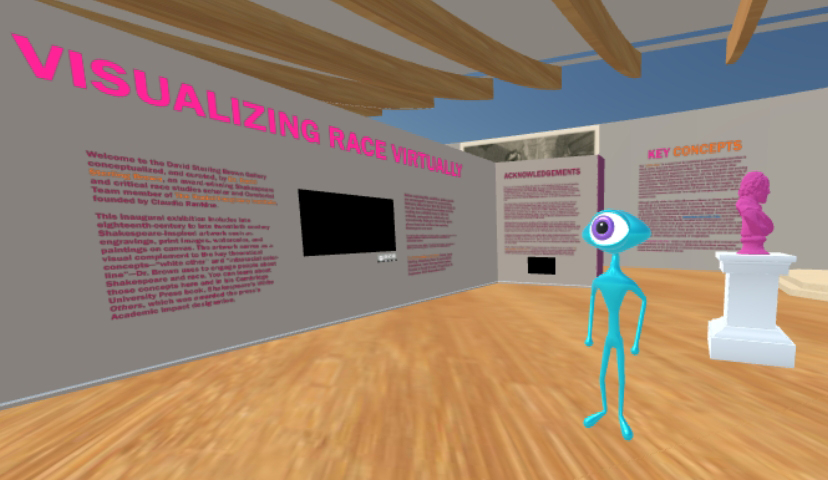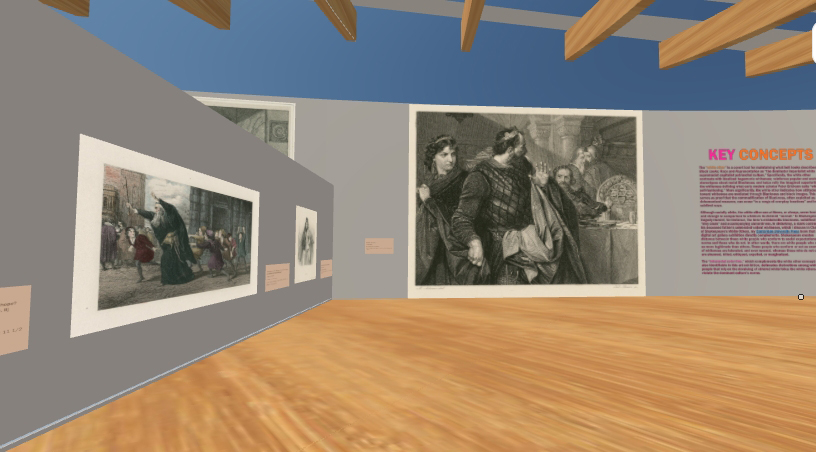‘Visualizing Race Virtually’: Explore an Interactive Art Gallery with Assoc. Prof. David Sterling Brown ’06
Standing in the art gallery he created to accompany his new book, Associate Professor of English David Sterling Brown ’06 is a thin blue alien with one giant purple eye.
At least, that’s the digital avatar he is using today as he shows me around the virtual space. When he speaks to me, he sees me as a gray rabbit with a pink nose.
Our incongruous avatars in this simulated world lighten the mood as our real-time audio chat touches on the serious subjects of race and racial representation, as seen through the plays of William Shakespeare—the topic of Brown’s recently published book, Shakespeare’s White Others (Cambridge University Press, 2023).

The web-based, immersive exhibit called Visualizing Race Virtually features 39 images from the Folger Shakespeare Library’s digital collection that depict scenes and characters from eight of the renowned writer’s plays: Macbeth, Much Ado About Nothing, Richard III, Othello, Romeo and Juliet, The Merchant of Venice, Titus Andronicus, and Hamlet.
“There are distinctions in Shakespeare’s plays between ideal and less-than-ideal whiteness. Ideal whiteness is often aligned with the light or being enlightened,” says Brown, with his avatar’s head bobbing around. “Shakespeare and race is a hard conversation to have. This environment is something of a liberating distraction that alleviates some pressure. There’s a level of anonymity here that makes it slightly easier to engage with people.”
The artwork on the computer-generated walls is accompanied by notes, web links, and even researched video analyses produced by Trinity students from Brown’s spring 2023 course, “Shakespeare’s Other ‘Race Plays’ ”: Kathleen E. Adams ’23, Alexandra K. Boursican ’23, Elise Costello ’23, Kayla Killiebrew ’23, Terrence Logan ’24, Lily Kirn McMahon ’24, Xavier A. Mercado ’24, Adara Rosenberg ’25, Kellie M. Sablone ’23, Ayouba Swaray ’24, and Cassidy S. Willie-Lawes ’24. Brown’s gallery is copyrighted to protect the intellectual property created by him and his students, so each video analysis—much like the gallery itself—has a citation tag that includes information about how to credit the creators.

Brown has been working on this project for more than two years. A video introduction by Brown—in human form—welcomes guests and provides a bit of background on his research. The gallery can be explored via computer or tablet. Visitors may interact with the space and with other visitors much the way one would in a 3-D video game or a virtual reality metaverse. Brown tells me that one does not need virtual reality goggles, though they do enhance the immersive experience.
“A lot of times there are barriers when it comes to Shakespeare,” Brown says. “I’m on a mission to get people to know they can discuss Shakespeare and race, and this gives people another way to experience this subject.” The gallery is accessible to anyone and operates as a free pedagogical resource.
As I move through the gallery’s rooms using my computer mouse and arrow keys, I can turn on licensed music from Pulitzer Prize-winning composer Anthony Davis, which grows softer as I move away from the source.
I see a dedication to Brown’s mentor during his undergraduate years at Trinity, Milla Cozart Riggio, James J. Goodwin Professor of English, Emerita.
I can hop on the corner stage, where Brown hopes to host future talks and performances.
I can even write on the walls and can choose to share live video of myself to have conversations with others in the virtual gallery.
Brown says, “I wanted to present this as an intellectual game while encouraging critical thinking about the pieces on display. It’s like a real brick-and-mortar gallery; you should spend some time in it to think about the artwork and what the images mean.” A bookshelf in the gallery’s back room includes resources for further reading, including publications by Claudia Rankine’s Racial Imaginary Institute, of which Brown is a member.

“This gallery brings about conversations about how race permeates every facet of our lives,” Brown says. “I want people who read the book or visit the gallery to take action to make the world a little better.”
Access the David Sterling Brown Gallery here. Use your keyboard’s arrow keys and mouse or touchpad to navigate the gallery.
